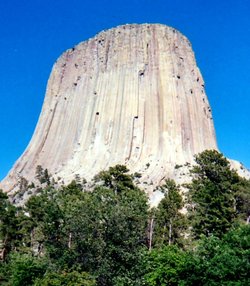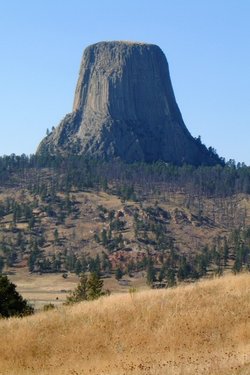Devils Tower National Monument
|
|
Devils Tower is a monolith (more technically, an igneous intrusion) located near Hulett and Sundance in eastern Wyoming, above the Belle Fourche River. It rises dramatically 1267 feet (386 m) above the surrounding terrain. Located at Template:Coor dms, the summit is 5112 feet (1558 m) above sea level.
It is part of the first United States National Monument, established on September 24, 1906. 1347 acres (545 ha) are included within the Monument's boundaries.
In recent years about 1% of the Monument's 400,000 annual visitors climb Devils Tower. The monolith is featured prominently in the 1977 film Close Encounters of the Third Kind.
| Contents |
Name
Tribes including the Arapaho, Crow, Cheyenne, Kiowa, Lakota, and Shoshone have had cultural and geographical ties to the monolith long before European and early American immigrants reached Wyoming. Their names for the monolith include: Aloft on a Rock (Kiowa), Bear's House (Cheyenne, Crow), Bear's Lair (Cheyenne, Crow), Bear's Lodge (Cheyenne, Lakota), Bear's Lodge Butte (Lakota), Bear's Tipi (Arapaho, Cheyenne), Tree Rock (Kiowa), and Grizzly Bear Lodge (Lakota).
In 2005, a proposal to recognize these ties through the additional designation of the monolith as Bear Lodge National Historic Landmark met with opposition from Rep. Barbara Cubin, arguing that a "name change will harm the tourist trade and bring economic hardship to area communities" [1] (http://www.house.gov/cubin/news/2005/March08e.html).
Geological history
Most of the landscape surrounding Devils Tower is composed of sedimentary rocks.
The oldest rocks visible in Devils Tower National Monument were laid down in a shallow sea during the Triassic period, 225 to 195 million years ago. This dark red sandstone and maroon siltstone, interbedded with shale, can be seen along the Belle Fourche River. Oxidation of iron minerals causes the redness of the rocks. This rock layer is known as the Spearfish formation.
Above the Spearfish formation is a thin band of white gypsum, called the Gypsum Spring formation. This layer of gypsum was deposited during the Jurassic period, 195 to 136 million years ago.
Seas retreated and returned. Climates changed and changed again. Gray-green shales (deposited in low-oxygen environments such as marshes) were interbedded with fine-grained sandstones, limestones, and sometimes thin beds of red mudstone. This composition, called the Stockade Beaver member, is part of the Sundance formation. The Hulett Sandstone member, also part of the Sundance formation, is composed of yellow fine-grained sandstone. Resistant to weathering, it forms the nearly vertical cliffs which encircle the Tower itself.
Seas again retreated and advanced. Landforms were eroded; new sediments were deposited. About 65 million years ago, during the Tertiary period, pressures within the earth climaxed, uplifting the Rocky Mountains and the Black Hills. Molten magma welled up toward the surface of the earth, intruding into already-existing sedimentary rock layers.
Theories of formation
Devils_Tower_portrait.png
Geologists agree that Devils Tower was formed by the intrusion of igneous material. What they cannot agree upon is how, exactly, that process took place. Geologists Carpenter and Russell studied Devils Tower in the late 1800s and came to the conclusion that the Tower was indeed formed by an igneous intrusion. Later geologists searched for further explanations.
In 1907, scientists Darton and O'Hara decided that Devils Tower must be an eroded remnant of a laccolith. A laccolith is a large mass of igneous rock which is intruded through sedimentary rock beds but does not actually reach the surface, producing a rounded bulge in the sedimentary layers above. This theory was quite popular in the early 1900s since numerous studies had earlier been done on a number of laccoliths in the Southwest.
Other theories have suggested that Devils Tower is a volcanic plug or that it is the neck of an extinct volcano. These explanations are unlikely, however, for there is no evidence of volcanic activity (volcanic ash, lava flows, or volcanic debris) anywhere in the surrounding countryside.
No one yet has a definite answer as to how exactly Devils Tower was formed, other than that it was an igneous intrusion into the sedimentary layers above and that the molten rock comprising the Tower did not surface.
In any case, geologists agree that the igneous material intruded and then cooled as phonolite porphyry, a light to dark-gray or greenish-gray igneous rock with conspicuous crystals of white feldspar. As the lava cooled, hexagonal (and sometimes 4-, 5-, and 7-sided) columns formed. As the columns continued to cool, vertical cracks developed as the columns shrank horizontally in volume (see also Devils Postpile National Monument).
Until erosion began its relentless work, Devils Tower was not visible above the overlying sedimentary rocks. But the forces of erosion, particularly that of water, began to wear away the sandstones and shales. The much harder igneous rock survived the onslaught of erosional forces, and the gray columns of Devils Tower began to appear above the surrounding landscape.
As rain and snow continue to erode the sedimentary rocks surrounding the Tower's base, and the Belle Fourche River carries away the debris, more of Devils Tower will be exposed. But at the same time, the Tower itself is slowly being eroded. Rocks are continually breaking off and falling from the steep walls. Rarely do entire columns fall, but on remote occasions, they do. Piles of rubble - broken columns, boulders, small rocks, and stones - lie at the base of the Tower, indicating that it was, at some time in the past, larger than it is today.
Recent history
Fur trappers may have visited Devils Tower, but they left no written evidence of having done so. The first documented visitors were several members of Captain W. F. Raynold's Yellowstone Expedition who arrived in 1859. Sixteen years later, Colonel Richard I. Dodge led a U.S. Geological Survey party to the massive rock formation and coined the name Devils Tower. Recognizing its unique characteristics, Congress designated the area a U.S. forest reserve in 1892 and in 1906 Devils Tower became the nation's first national monument.
On July 4, 1893, local rancher William Rogers became the first person to complete the climb after constructing a ladder of wooden pegs driven into cracks in the rock face. Technical rock climbing techniques were first used to ascend the Tower in 1937 when Fritz Wiessner reached the summit with a small party from the American Alpine Club. Today hundreds of climbers scale the sheer rock walls each summer; each lava column defines its own climbing routes, whose difficulties range from easy to some of the hardest in the world. On some routes the gap between columns is just narrow enough to bridge with stretched-out legs, so the climber ascends doing "the splits" all the way. All climbers must register with a park ranger before and after attempting a climb.
Native American folklore
American Indian legends tell of a few Sioux girls who were picking flowers when they were chased by bears. Feeling sorry for them, the Great Spirit raised the ground beneath the girls. The bears fell off, leaving their scratch marks on the sides.
External links
- Devils Tower National Monument (http://www.nps.gov/deto/), the National Park Service website
- Indian Religious Freedom at Devilís Tower National Monument (http://www.indianlaw.org/devils_tower.html), from the Indian Law Resource Center websitede:Devils Tower National Monument
fr:Devils Tower National Monument id:Monumen Nasional Menara Setan


